PPMP 20009: Complex Project Management of the Grand Ethiopian Dam
VerifiedAdded on 2023/03/30
|27
|6338
|213
Report
AI Summary
This report provides an analysis of the Grand Ethiopian Renaissance Dam (GERD) project, focusing on its complex project management aspects. It discusses the background of the GERD, its potential benefits for Ethiopia, and the controversies surrounding its construction, particularly the concerns raised by Egypt regarding water supply. The report identifies and categorizes the complexities involved in the project into structural, directional, technical, and temporal dimensions, highlighting issues such as corruption, geopolitical tensions, and technical challenges. The analysis considers the impact of these complexities on the project's timeline and overall success, offering insights into the challenges and potential solutions for managing large-scale infrastructure projects in politically sensitive environments. Desklib offers more solved assignments and resources for students.
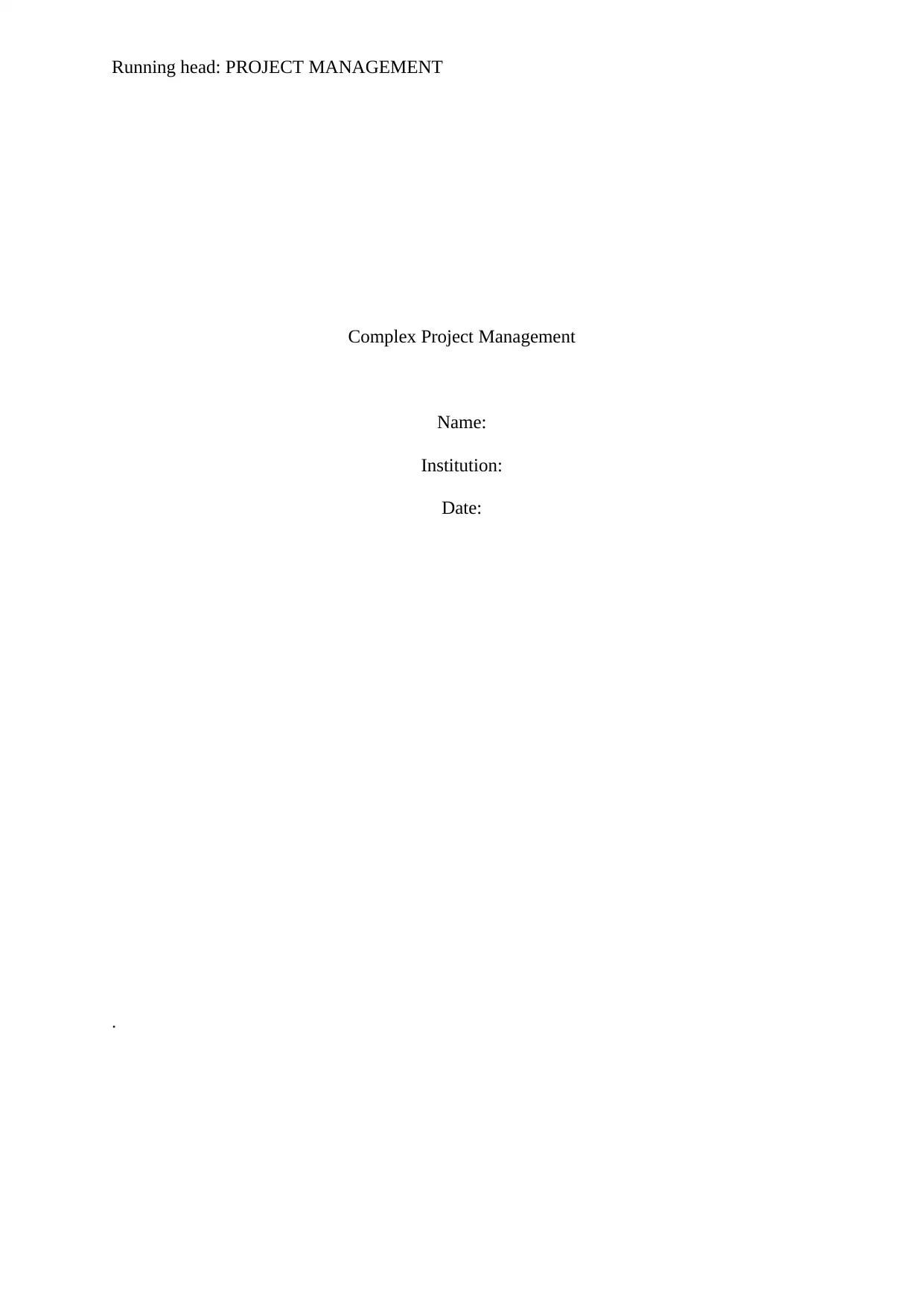
Running head: PROJECT MANAGEMENT
Complex Project Management
Name:
Institution:
Date:
.
Complex Project Management
Name:
Institution:
Date:
.
Paraphrase This Document
Need a fresh take? Get an instant paraphrase of this document with our AI Paraphraser
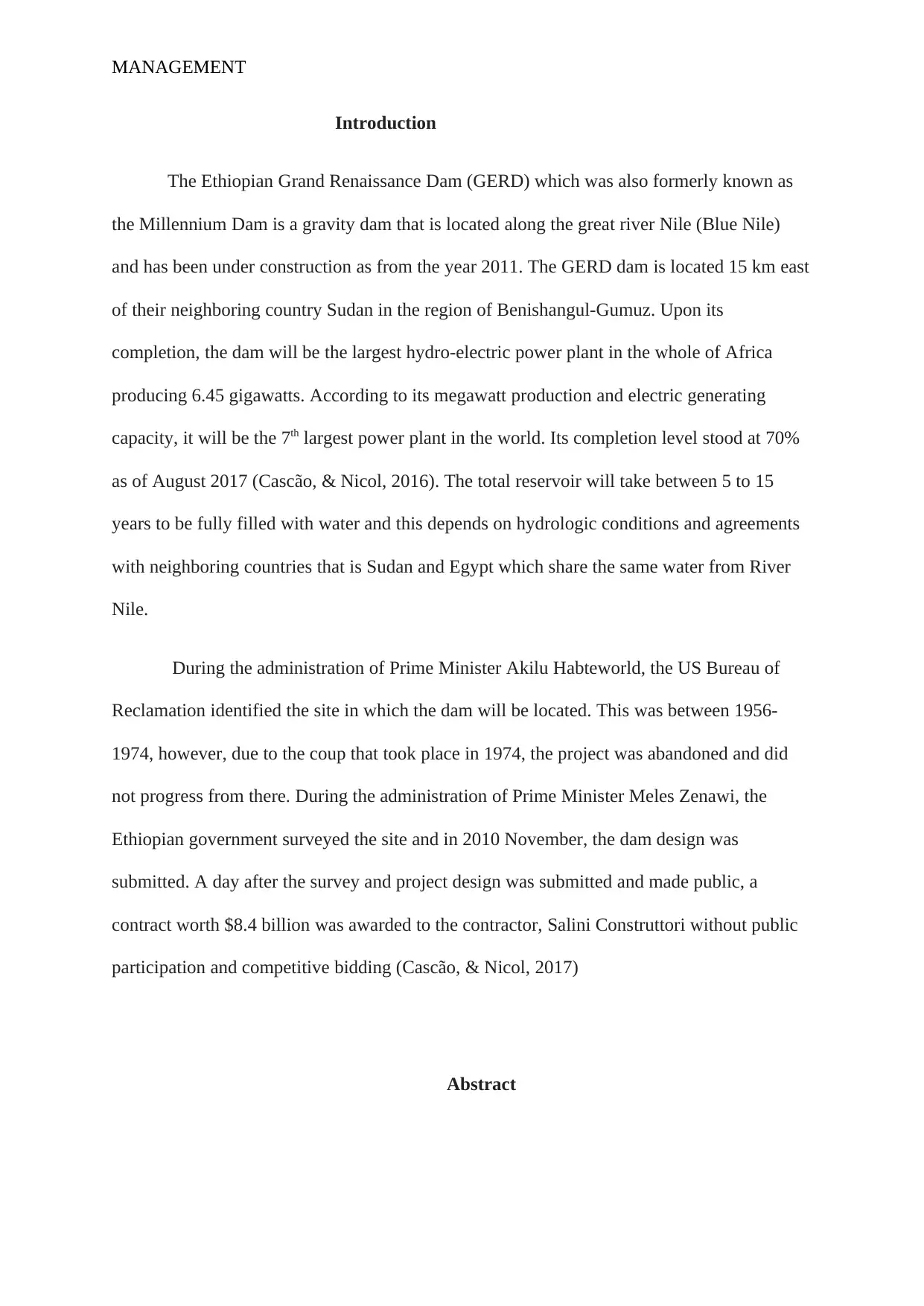
MANAGEMENT
Introduction
The Ethiopian Grand Renaissance Dam (GERD) which was also formerly known as
the Millennium Dam is a gravity dam that is located along the great river Nile (Blue Nile)
and has been under construction as from the year 2011. The GERD dam is located 15 km east
of their neighboring country Sudan in the region of Benishangul-Gumuz. Upon its
completion, the dam will be the largest hydro-electric power plant in the whole of Africa
producing 6.45 gigawatts. According to its megawatt production and electric generating
capacity, it will be the 7th largest power plant in the world. Its completion level stood at 70%
as of August 2017 (Cascão, & Nicol, 2016). The total reservoir will take between 5 to 15
years to be fully filled with water and this depends on hydrologic conditions and agreements
with neighboring countries that is Sudan and Egypt which share the same water from River
Nile.
During the administration of Prime Minister Akilu Habteworld, the US Bureau of
Reclamation identified the site in which the dam will be located. This was between 1956-
1974, however, due to the coup that took place in 1974, the project was abandoned and did
not progress from there. During the administration of Prime Minister Meles Zenawi, the
Ethiopian government surveyed the site and in 2010 November, the dam design was
submitted. A day after the survey and project design was submitted and made public, a
contract worth $8.4 billion was awarded to the contractor, Salini Construttori without public
participation and competitive bidding (Cascão, & Nicol, 2017)
Abstract
Introduction
The Ethiopian Grand Renaissance Dam (GERD) which was also formerly known as
the Millennium Dam is a gravity dam that is located along the great river Nile (Blue Nile)
and has been under construction as from the year 2011. The GERD dam is located 15 km east
of their neighboring country Sudan in the region of Benishangul-Gumuz. Upon its
completion, the dam will be the largest hydro-electric power plant in the whole of Africa
producing 6.45 gigawatts. According to its megawatt production and electric generating
capacity, it will be the 7th largest power plant in the world. Its completion level stood at 70%
as of August 2017 (Cascão, & Nicol, 2016). The total reservoir will take between 5 to 15
years to be fully filled with water and this depends on hydrologic conditions and agreements
with neighboring countries that is Sudan and Egypt which share the same water from River
Nile.
During the administration of Prime Minister Akilu Habteworld, the US Bureau of
Reclamation identified the site in which the dam will be located. This was between 1956-
1974, however, due to the coup that took place in 1974, the project was abandoned and did
not progress from there. During the administration of Prime Minister Meles Zenawi, the
Ethiopian government surveyed the site and in 2010 November, the dam design was
submitted. A day after the survey and project design was submitted and made public, a
contract worth $8.4 billion was awarded to the contractor, Salini Construttori without public
participation and competitive bidding (Cascão, & Nicol, 2017)
Abstract
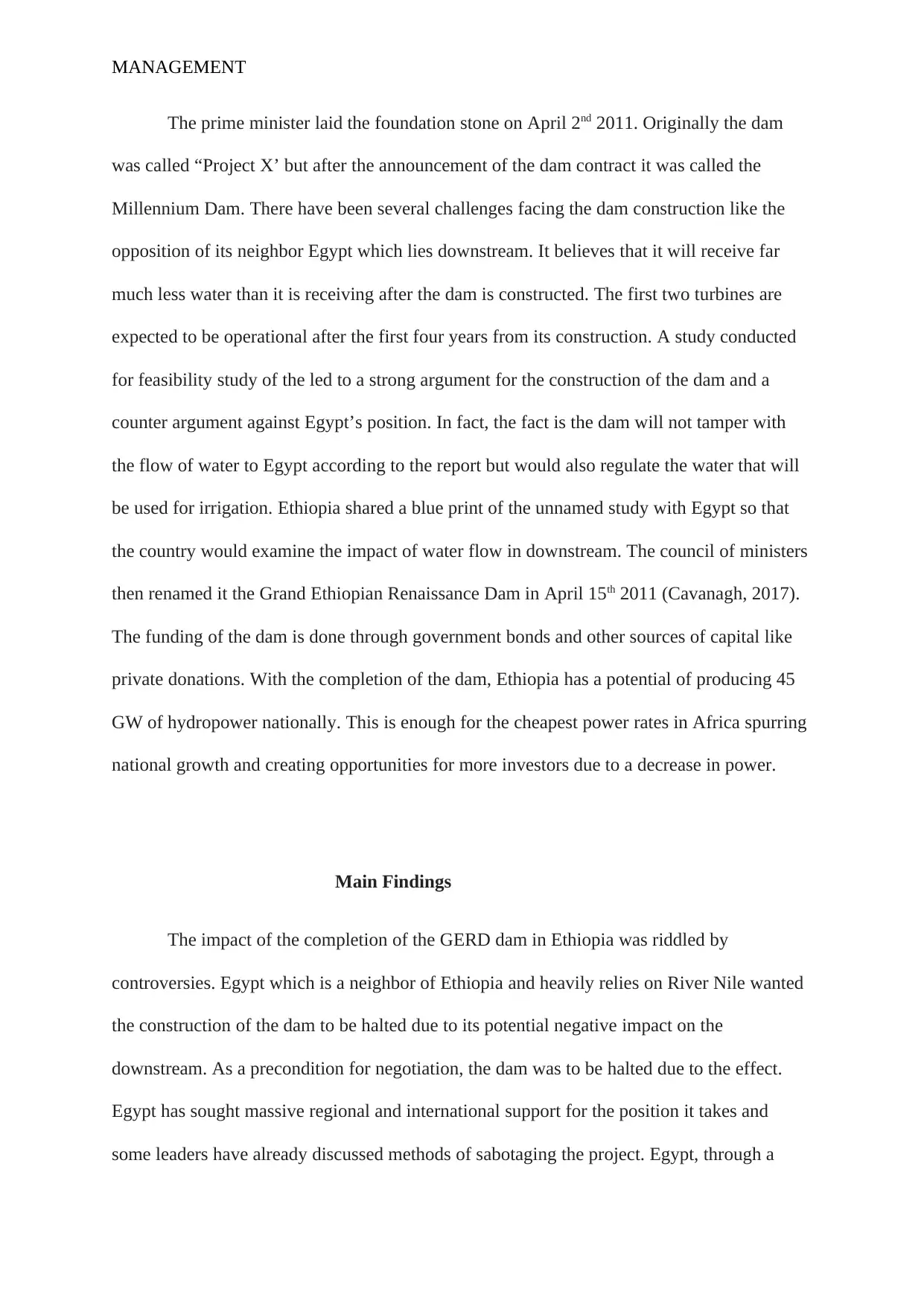
MANAGEMENT
The prime minister laid the foundation stone on April 2nd 2011. Originally the dam
was called “Project X’ but after the announcement of the dam contract it was called the
Millennium Dam. There have been several challenges facing the dam construction like the
opposition of its neighbor Egypt which lies downstream. It believes that it will receive far
much less water than it is receiving after the dam is constructed. The first two turbines are
expected to be operational after the first four years from its construction. A study conducted
for feasibility study of the led to a strong argument for the construction of the dam and a
counter argument against Egypt’s position. In fact, the fact is the dam will not tamper with
the flow of water to Egypt according to the report but would also regulate the water that will
be used for irrigation. Ethiopia shared a blue print of the unnamed study with Egypt so that
the country would examine the impact of water flow in downstream. The council of ministers
then renamed it the Grand Ethiopian Renaissance Dam in April 15th 2011 (Cavanagh, 2017).
The funding of the dam is done through government bonds and other sources of capital like
private donations. With the completion of the dam, Ethiopia has a potential of producing 45
GW of hydropower nationally. This is enough for the cheapest power rates in Africa spurring
national growth and creating opportunities for more investors due to a decrease in power.
Main Findings
The impact of the completion of the GERD dam in Ethiopia was riddled by
controversies. Egypt which is a neighbor of Ethiopia and heavily relies on River Nile wanted
the construction of the dam to be halted due to its potential negative impact on the
downstream. As a precondition for negotiation, the dam was to be halted due to the effect.
Egypt has sought massive regional and international support for the position it takes and
some leaders have already discussed methods of sabotaging the project. Egypt, through a
The prime minister laid the foundation stone on April 2nd 2011. Originally the dam
was called “Project X’ but after the announcement of the dam contract it was called the
Millennium Dam. There have been several challenges facing the dam construction like the
opposition of its neighbor Egypt which lies downstream. It believes that it will receive far
much less water than it is receiving after the dam is constructed. The first two turbines are
expected to be operational after the first four years from its construction. A study conducted
for feasibility study of the led to a strong argument for the construction of the dam and a
counter argument against Egypt’s position. In fact, the fact is the dam will not tamper with
the flow of water to Egypt according to the report but would also regulate the water that will
be used for irrigation. Ethiopia shared a blue print of the unnamed study with Egypt so that
the country would examine the impact of water flow in downstream. The council of ministers
then renamed it the Grand Ethiopian Renaissance Dam in April 15th 2011 (Cavanagh, 2017).
The funding of the dam is done through government bonds and other sources of capital like
private donations. With the completion of the dam, Ethiopia has a potential of producing 45
GW of hydropower nationally. This is enough for the cheapest power rates in Africa spurring
national growth and creating opportunities for more investors due to a decrease in power.
Main Findings
The impact of the completion of the GERD dam in Ethiopia was riddled by
controversies. Egypt which is a neighbor of Ethiopia and heavily relies on River Nile wanted
the construction of the dam to be halted due to its potential negative impact on the
downstream. As a precondition for negotiation, the dam was to be halted due to the effect.
Egypt has sought massive regional and international support for the position it takes and
some leaders have already discussed methods of sabotaging the project. Egypt, through a
⊘ This is a preview!⊘
Do you want full access?
Subscribe today to unlock all pages.

Trusted by 1+ million students worldwide
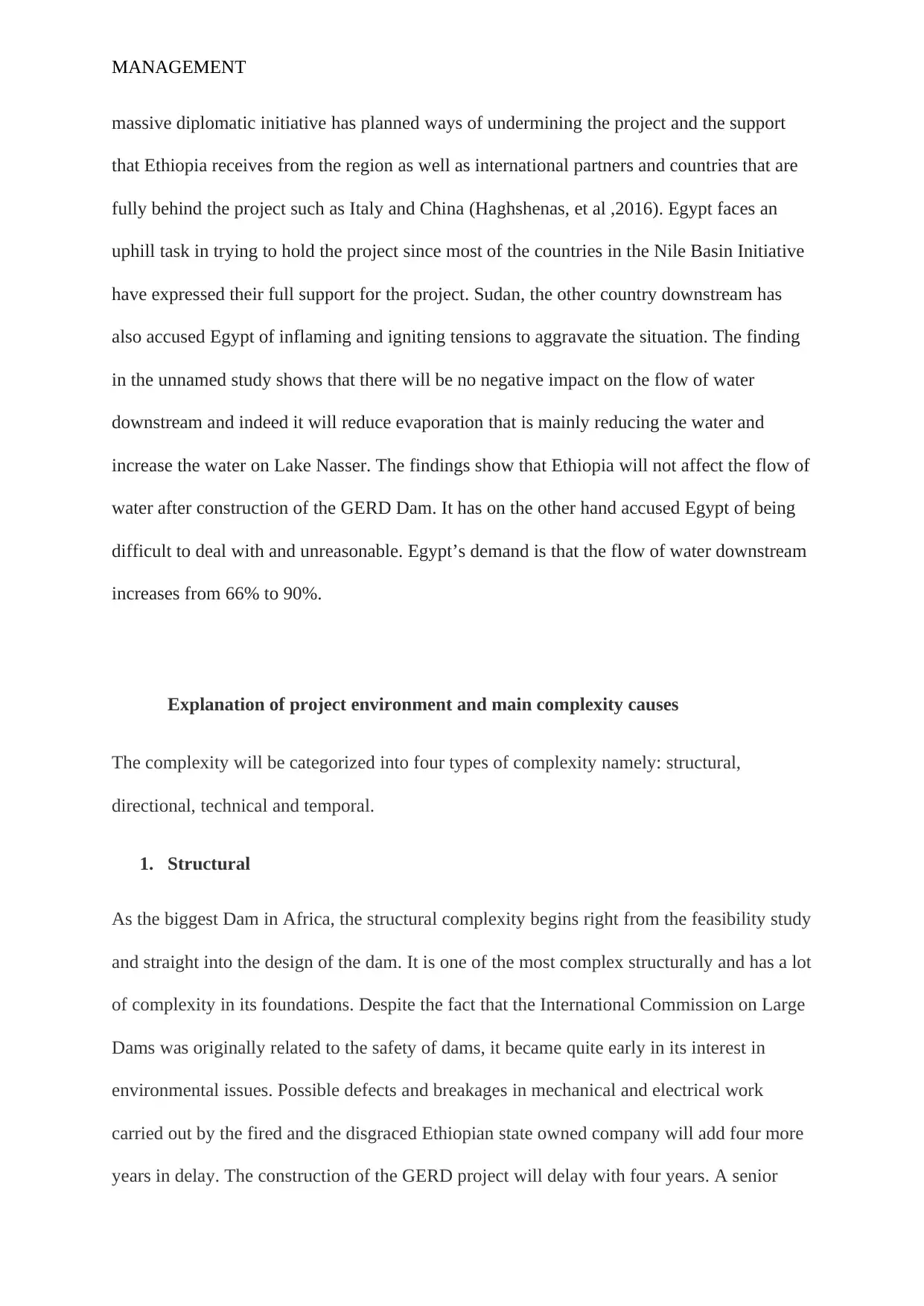
MANAGEMENT
massive diplomatic initiative has planned ways of undermining the project and the support
that Ethiopia receives from the region as well as international partners and countries that are
fully behind the project such as Italy and China (Haghshenas, et al ,2016). Egypt faces an
uphill task in trying to hold the project since most of the countries in the Nile Basin Initiative
have expressed their full support for the project. Sudan, the other country downstream has
also accused Egypt of inflaming and igniting tensions to aggravate the situation. The finding
in the unnamed study shows that there will be no negative impact on the flow of water
downstream and indeed it will reduce evaporation that is mainly reducing the water and
increase the water on Lake Nasser. The findings show that Ethiopia will not affect the flow of
water after construction of the GERD Dam. It has on the other hand accused Egypt of being
difficult to deal with and unreasonable. Egypt’s demand is that the flow of water downstream
increases from 66% to 90%.
Explanation of project environment and main complexity causes
The complexity will be categorized into four types of complexity namely: structural,
directional, technical and temporal.
1. Structural
As the biggest Dam in Africa, the structural complexity begins right from the feasibility study
and straight into the design of the dam. It is one of the most complex structurally and has a lot
of complexity in its foundations. Despite the fact that the International Commission on Large
Dams was originally related to the safety of dams, it became quite early in its interest in
environmental issues. Possible defects and breakages in mechanical and electrical work
carried out by the fired and the disgraced Ethiopian state owned company will add four more
years in delay. The construction of the GERD project will delay with four years. A senior
massive diplomatic initiative has planned ways of undermining the project and the support
that Ethiopia receives from the region as well as international partners and countries that are
fully behind the project such as Italy and China (Haghshenas, et al ,2016). Egypt faces an
uphill task in trying to hold the project since most of the countries in the Nile Basin Initiative
have expressed their full support for the project. Sudan, the other country downstream has
also accused Egypt of inflaming and igniting tensions to aggravate the situation. The finding
in the unnamed study shows that there will be no negative impact on the flow of water
downstream and indeed it will reduce evaporation that is mainly reducing the water and
increase the water on Lake Nasser. The findings show that Ethiopia will not affect the flow of
water after construction of the GERD Dam. It has on the other hand accused Egypt of being
difficult to deal with and unreasonable. Egypt’s demand is that the flow of water downstream
increases from 66% to 90%.
Explanation of project environment and main complexity causes
The complexity will be categorized into four types of complexity namely: structural,
directional, technical and temporal.
1. Structural
As the biggest Dam in Africa, the structural complexity begins right from the feasibility study
and straight into the design of the dam. It is one of the most complex structurally and has a lot
of complexity in its foundations. Despite the fact that the International Commission on Large
Dams was originally related to the safety of dams, it became quite early in its interest in
environmental issues. Possible defects and breakages in mechanical and electrical work
carried out by the fired and the disgraced Ethiopian state owned company will add four more
years in delay. The construction of the GERD project will delay with four years. A senior
Paraphrase This Document
Need a fresh take? Get an instant paraphrase of this document with our AI Paraphraser
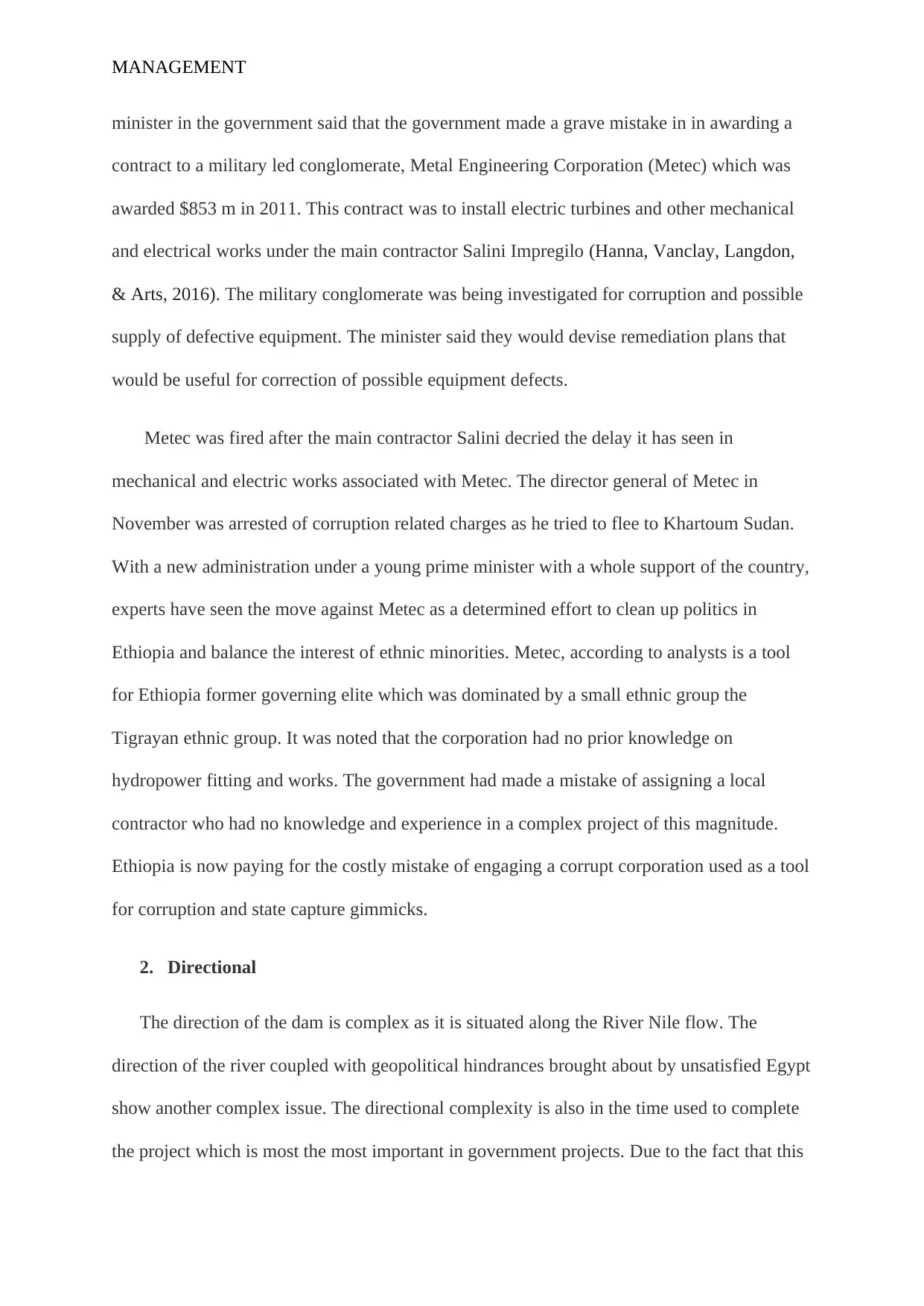
MANAGEMENT
minister in the government said that the government made a grave mistake in in awarding a
contract to a military led conglomerate, Metal Engineering Corporation (Metec) which was
awarded $853 m in 2011. This contract was to install electric turbines and other mechanical
and electrical works under the main contractor Salini Impregilo (Hanna, Vanclay, Langdon,
& Arts, 2016). The military conglomerate was being investigated for corruption and possible
supply of defective equipment. The minister said they would devise remediation plans that
would be useful for correction of possible equipment defects.
Metec was fired after the main contractor Salini decried the delay it has seen in
mechanical and electric works associated with Metec. The director general of Metec in
November was arrested of corruption related charges as he tried to flee to Khartoum Sudan.
With a new administration under a young prime minister with a whole support of the country,
experts have seen the move against Metec as a determined effort to clean up politics in
Ethiopia and balance the interest of ethnic minorities. Metec, according to analysts is a tool
for Ethiopia former governing elite which was dominated by a small ethnic group the
Tigrayan ethnic group. It was noted that the corporation had no prior knowledge on
hydropower fitting and works. The government had made a mistake of assigning a local
contractor who had no knowledge and experience in a complex project of this magnitude.
Ethiopia is now paying for the costly mistake of engaging a corrupt corporation used as a tool
for corruption and state capture gimmicks.
2. Directional
The direction of the dam is complex as it is situated along the River Nile flow. The
direction of the river coupled with geopolitical hindrances brought about by unsatisfied Egypt
show another complex issue. The directional complexity is also in the time used to complete
the project which is most the most important in government projects. Due to the fact that this
minister in the government said that the government made a grave mistake in in awarding a
contract to a military led conglomerate, Metal Engineering Corporation (Metec) which was
awarded $853 m in 2011. This contract was to install electric turbines and other mechanical
and electrical works under the main contractor Salini Impregilo (Hanna, Vanclay, Langdon,
& Arts, 2016). The military conglomerate was being investigated for corruption and possible
supply of defective equipment. The minister said they would devise remediation plans that
would be useful for correction of possible equipment defects.
Metec was fired after the main contractor Salini decried the delay it has seen in
mechanical and electric works associated with Metec. The director general of Metec in
November was arrested of corruption related charges as he tried to flee to Khartoum Sudan.
With a new administration under a young prime minister with a whole support of the country,
experts have seen the move against Metec as a determined effort to clean up politics in
Ethiopia and balance the interest of ethnic minorities. Metec, according to analysts is a tool
for Ethiopia former governing elite which was dominated by a small ethnic group the
Tigrayan ethnic group. It was noted that the corporation had no prior knowledge on
hydropower fitting and works. The government had made a mistake of assigning a local
contractor who had no knowledge and experience in a complex project of this magnitude.
Ethiopia is now paying for the costly mistake of engaging a corrupt corporation used as a tool
for corruption and state capture gimmicks.
2. Directional
The direction of the dam is complex as it is situated along the River Nile flow. The
direction of the river coupled with geopolitical hindrances brought about by unsatisfied Egypt
show another complex issue. The directional complexity is also in the time used to complete
the project which is most the most important in government projects. Due to the fact that this
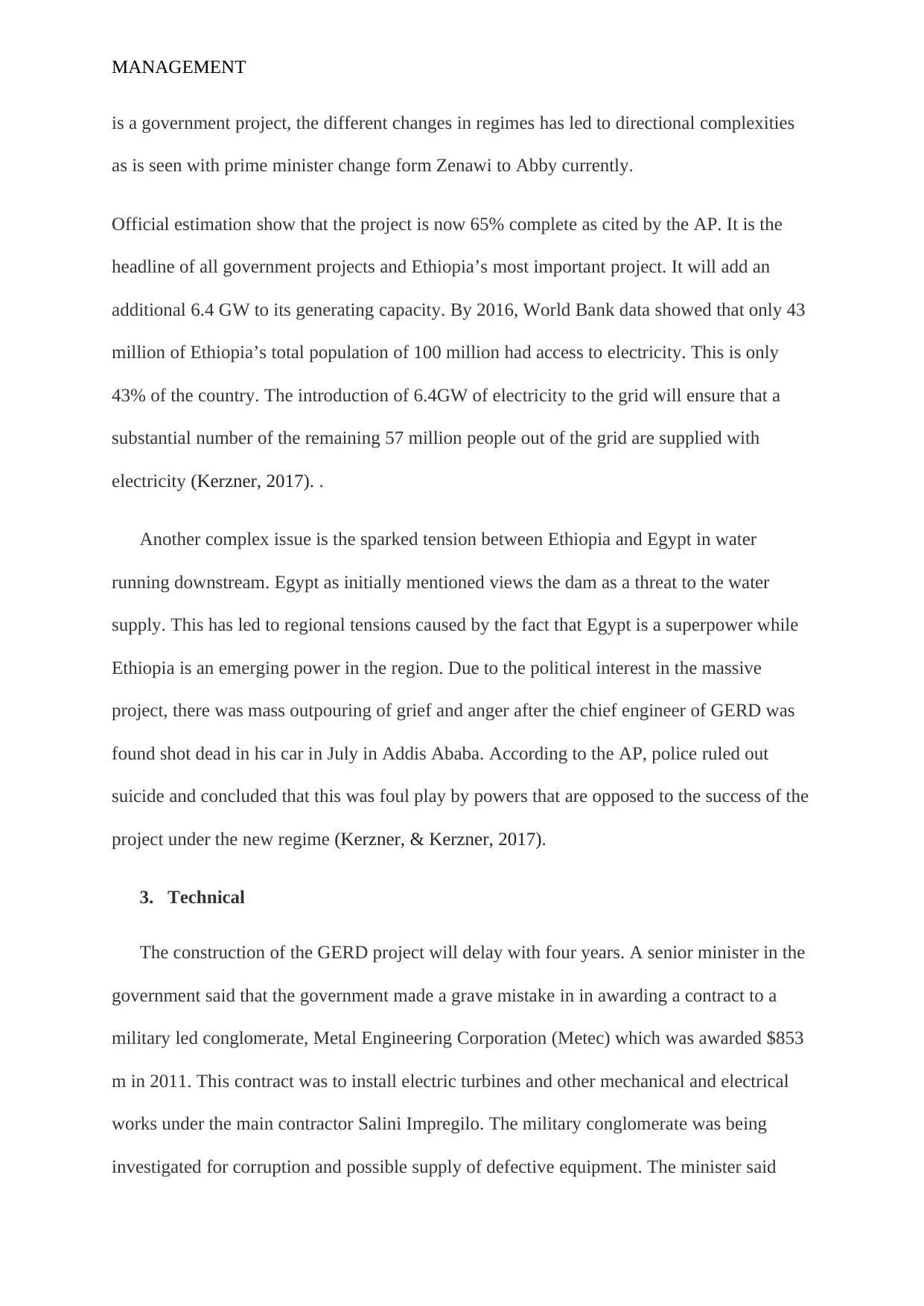
MANAGEMENT
is a government project, the different changes in regimes has led to directional complexities
as is seen with prime minister change form Zenawi to Abby currently.
Official estimation show that the project is now 65% complete as cited by the AP. It is the
headline of all government projects and Ethiopia’s most important project. It will add an
additional 6.4 GW to its generating capacity. By 2016, World Bank data showed that only 43
million of Ethiopia’s total population of 100 million had access to electricity. This is only
43% of the country. The introduction of 6.4GW of electricity to the grid will ensure that a
substantial number of the remaining 57 million people out of the grid are supplied with
electricity (Kerzner, 2017). .
Another complex issue is the sparked tension between Ethiopia and Egypt in water
running downstream. Egypt as initially mentioned views the dam as a threat to the water
supply. This has led to regional tensions caused by the fact that Egypt is a superpower while
Ethiopia is an emerging power in the region. Due to the political interest in the massive
project, there was mass outpouring of grief and anger after the chief engineer of GERD was
found shot dead in his car in July in Addis Ababa. According to the AP, police ruled out
suicide and concluded that this was foul play by powers that are opposed to the success of the
project under the new regime (Kerzner, & Kerzner, 2017).
3. Technical
The construction of the GERD project will delay with four years. A senior minister in the
government said that the government made a grave mistake in in awarding a contract to a
military led conglomerate, Metal Engineering Corporation (Metec) which was awarded $853
m in 2011. This contract was to install electric turbines and other mechanical and electrical
works under the main contractor Salini Impregilo. The military conglomerate was being
investigated for corruption and possible supply of defective equipment. The minister said
is a government project, the different changes in regimes has led to directional complexities
as is seen with prime minister change form Zenawi to Abby currently.
Official estimation show that the project is now 65% complete as cited by the AP. It is the
headline of all government projects and Ethiopia’s most important project. It will add an
additional 6.4 GW to its generating capacity. By 2016, World Bank data showed that only 43
million of Ethiopia’s total population of 100 million had access to electricity. This is only
43% of the country. The introduction of 6.4GW of electricity to the grid will ensure that a
substantial number of the remaining 57 million people out of the grid are supplied with
electricity (Kerzner, 2017). .
Another complex issue is the sparked tension between Ethiopia and Egypt in water
running downstream. Egypt as initially mentioned views the dam as a threat to the water
supply. This has led to regional tensions caused by the fact that Egypt is a superpower while
Ethiopia is an emerging power in the region. Due to the political interest in the massive
project, there was mass outpouring of grief and anger after the chief engineer of GERD was
found shot dead in his car in July in Addis Ababa. According to the AP, police ruled out
suicide and concluded that this was foul play by powers that are opposed to the success of the
project under the new regime (Kerzner, & Kerzner, 2017).
3. Technical
The construction of the GERD project will delay with four years. A senior minister in the
government said that the government made a grave mistake in in awarding a contract to a
military led conglomerate, Metal Engineering Corporation (Metec) which was awarded $853
m in 2011. This contract was to install electric turbines and other mechanical and electrical
works under the main contractor Salini Impregilo. The military conglomerate was being
investigated for corruption and possible supply of defective equipment. The minister said
⊘ This is a preview!⊘
Do you want full access?
Subscribe today to unlock all pages.

Trusted by 1+ million students worldwide
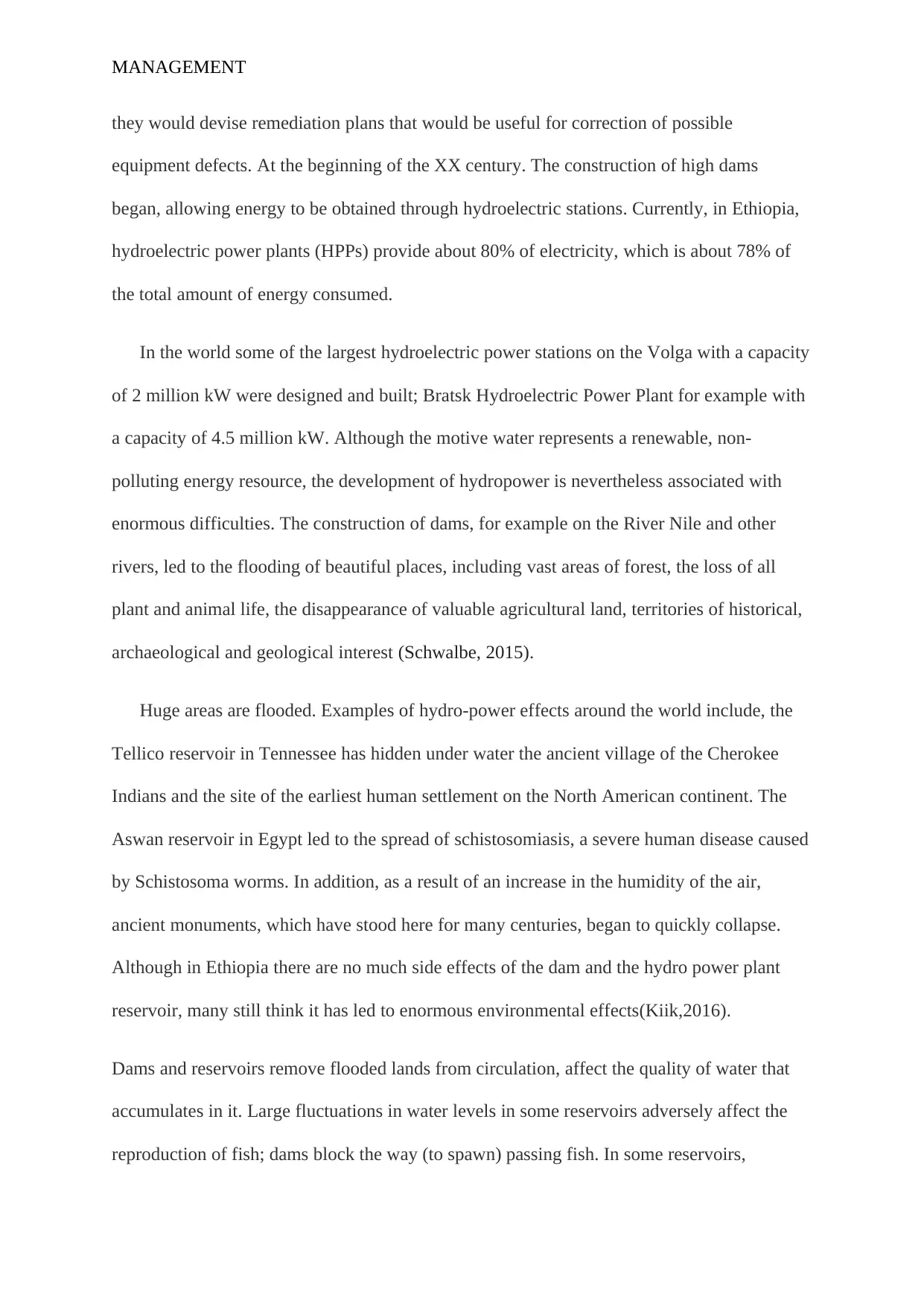
MANAGEMENT
they would devise remediation plans that would be useful for correction of possible
equipment defects. At the beginning of the XX century. The construction of high dams
began, allowing energy to be obtained through hydroelectric stations. Currently, in Ethiopia,
hydroelectric power plants (HPPs) provide about 80% of electricity, which is about 78% of
the total amount of energy consumed.
In the world some of the largest hydroelectric power stations on the Volga with a capacity
of 2 million kW were designed and built; Bratsk Hydroelectric Power Plant for example with
a capacity of 4.5 million kW. Although the motive water represents a renewable, non-
polluting energy resource, the development of hydropower is nevertheless associated with
enormous difficulties. The construction of dams, for example on the River Nile and other
rivers, led to the flooding of beautiful places, including vast areas of forest, the loss of all
plant and animal life, the disappearance of valuable agricultural land, territories of historical,
archaeological and geological interest (Schwalbe, 2015).
Huge areas are flooded. Examples of hydro-power effects around the world include, the
Tellico reservoir in Tennessee has hidden under water the ancient village of the Cherokee
Indians and the site of the earliest human settlement on the North American continent. The
Aswan reservoir in Egypt led to the spread of schistosomiasis, a severe human disease caused
by Schistosoma worms. In addition, as a result of an increase in the humidity of the air,
ancient monuments, which have stood here for many centuries, began to quickly collapse.
Although in Ethiopia there are no much side effects of the dam and the hydro power plant
reservoir, many still think it has led to enormous environmental effects(Kiik,2016).
Dams and reservoirs remove flooded lands from circulation, affect the quality of water that
accumulates in it. Large fluctuations in water levels in some reservoirs adversely affect the
reproduction of fish; dams block the way (to spawn) passing fish. In some reservoirs,
they would devise remediation plans that would be useful for correction of possible
equipment defects. At the beginning of the XX century. The construction of high dams
began, allowing energy to be obtained through hydroelectric stations. Currently, in Ethiopia,
hydroelectric power plants (HPPs) provide about 80% of electricity, which is about 78% of
the total amount of energy consumed.
In the world some of the largest hydroelectric power stations on the Volga with a capacity
of 2 million kW were designed and built; Bratsk Hydroelectric Power Plant for example with
a capacity of 4.5 million kW. Although the motive water represents a renewable, non-
polluting energy resource, the development of hydropower is nevertheless associated with
enormous difficulties. The construction of dams, for example on the River Nile and other
rivers, led to the flooding of beautiful places, including vast areas of forest, the loss of all
plant and animal life, the disappearance of valuable agricultural land, territories of historical,
archaeological and geological interest (Schwalbe, 2015).
Huge areas are flooded. Examples of hydro-power effects around the world include, the
Tellico reservoir in Tennessee has hidden under water the ancient village of the Cherokee
Indians and the site of the earliest human settlement on the North American continent. The
Aswan reservoir in Egypt led to the spread of schistosomiasis, a severe human disease caused
by Schistosoma worms. In addition, as a result of an increase in the humidity of the air,
ancient monuments, which have stood here for many centuries, began to quickly collapse.
Although in Ethiopia there are no much side effects of the dam and the hydro power plant
reservoir, many still think it has led to enormous environmental effects(Kiik,2016).
Dams and reservoirs remove flooded lands from circulation, affect the quality of water that
accumulates in it. Large fluctuations in water levels in some reservoirs adversely affect the
reproduction of fish; dams block the way (to spawn) passing fish. In some reservoirs,
Paraphrase This Document
Need a fresh take? Get an instant paraphrase of this document with our AI Paraphraser
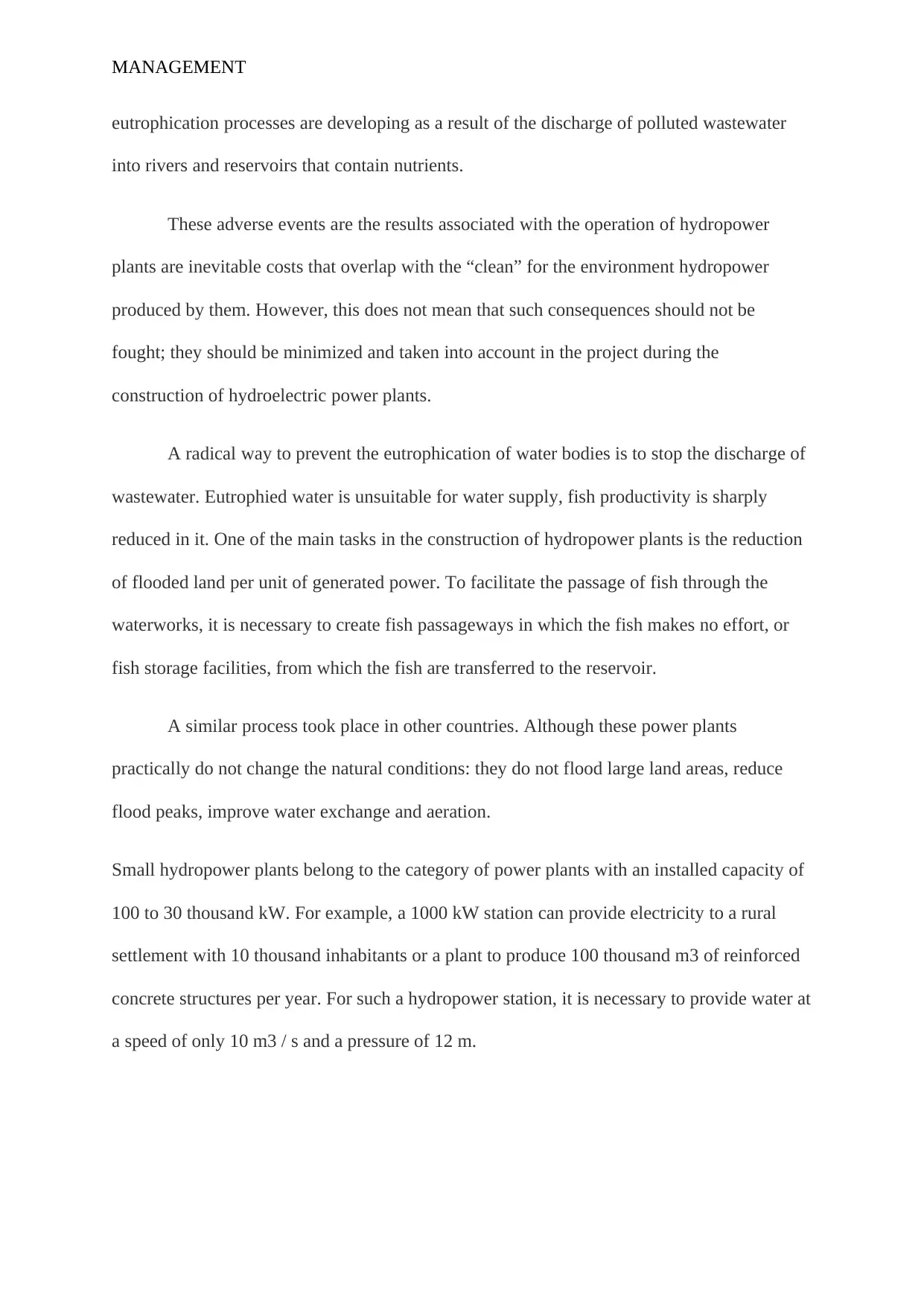
MANAGEMENT
eutrophication processes are developing as a result of the discharge of polluted wastewater
into rivers and reservoirs that contain nutrients.
These adverse events are the results associated with the operation of hydropower
plants are inevitable costs that overlap with the “clean” for the environment hydropower
produced by them. However, this does not mean that such consequences should not be
fought; they should be minimized and taken into account in the project during the
construction of hydroelectric power plants.
A radical way to prevent the eutrophication of water bodies is to stop the discharge of
wastewater. Eutrophied water is unsuitable for water supply, fish productivity is sharply
reduced in it. One of the main tasks in the construction of hydropower plants is the reduction
of flooded land per unit of generated power. To facilitate the passage of fish through the
waterworks, it is necessary to create fish passageways in which the fish makes no effort, or
fish storage facilities, from which the fish are transferred to the reservoir.
A similar process took place in other countries. Although these power plants
practically do not change the natural conditions: they do not flood large land areas, reduce
flood peaks, improve water exchange and aeration.
Small hydropower plants belong to the category of power plants with an installed capacity of
100 to 30 thousand kW. For example, a 1000 kW station can provide electricity to a rural
settlement with 10 thousand inhabitants or a plant to produce 100 thousand m3 of reinforced
concrete structures per year. For such a hydropower station, it is necessary to provide water at
a speed of only 10 m3 / s and a pressure of 12 m.
eutrophication processes are developing as a result of the discharge of polluted wastewater
into rivers and reservoirs that contain nutrients.
These adverse events are the results associated with the operation of hydropower
plants are inevitable costs that overlap with the “clean” for the environment hydropower
produced by them. However, this does not mean that such consequences should not be
fought; they should be minimized and taken into account in the project during the
construction of hydroelectric power plants.
A radical way to prevent the eutrophication of water bodies is to stop the discharge of
wastewater. Eutrophied water is unsuitable for water supply, fish productivity is sharply
reduced in it. One of the main tasks in the construction of hydropower plants is the reduction
of flooded land per unit of generated power. To facilitate the passage of fish through the
waterworks, it is necessary to create fish passageways in which the fish makes no effort, or
fish storage facilities, from which the fish are transferred to the reservoir.
A similar process took place in other countries. Although these power plants
practically do not change the natural conditions: they do not flood large land areas, reduce
flood peaks, improve water exchange and aeration.
Small hydropower plants belong to the category of power plants with an installed capacity of
100 to 30 thousand kW. For example, a 1000 kW station can provide electricity to a rural
settlement with 10 thousand inhabitants or a plant to produce 100 thousand m3 of reinforced
concrete structures per year. For such a hydropower station, it is necessary to provide water at
a speed of only 10 m3 / s and a pressure of 12 m.
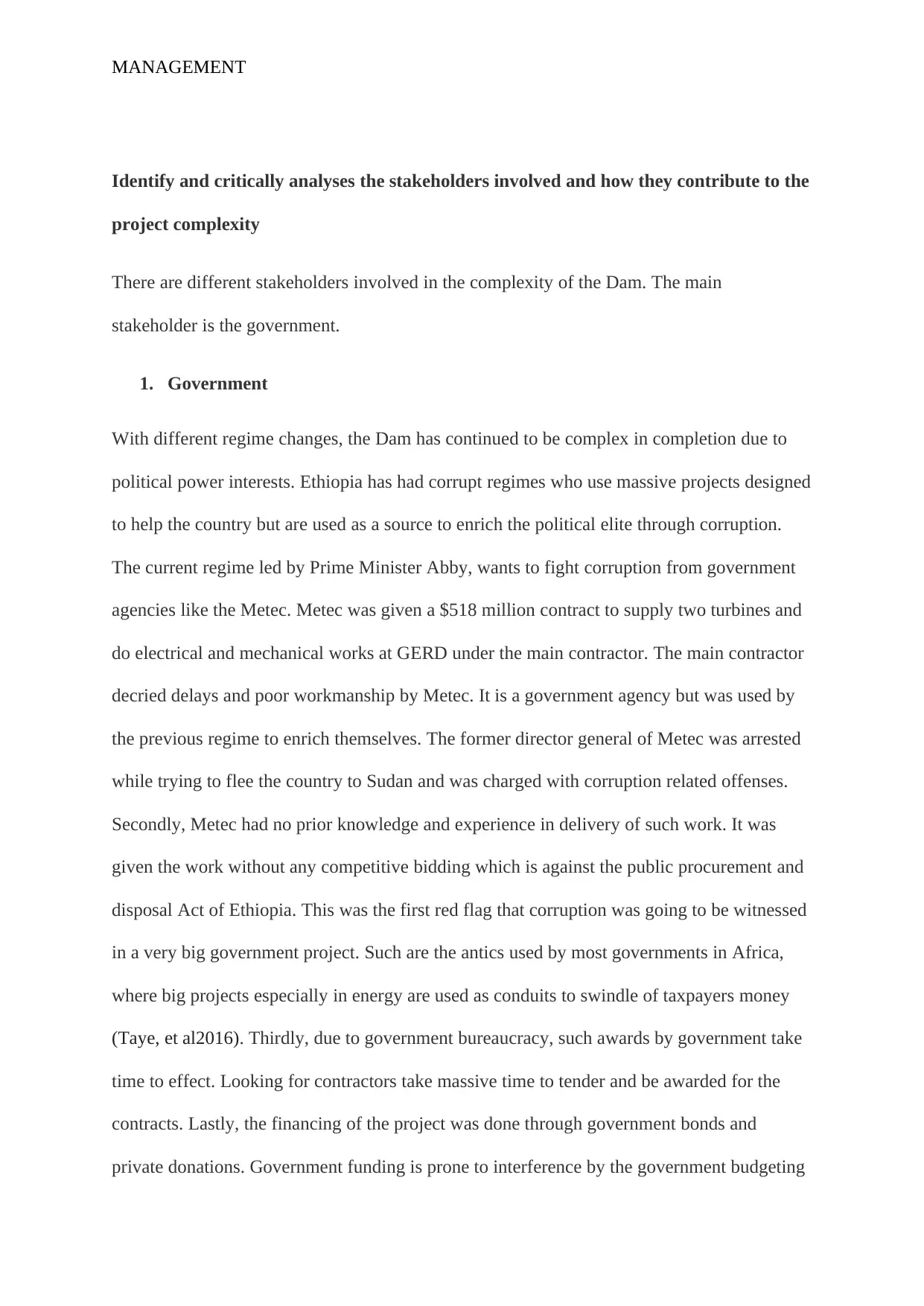
MANAGEMENT
Identify and critically analyses the stakeholders involved and how they contribute to the
project complexity
There are different stakeholders involved in the complexity of the Dam. The main
stakeholder is the government.
1. Government
With different regime changes, the Dam has continued to be complex in completion due to
political power interests. Ethiopia has had corrupt regimes who use massive projects designed
to help the country but are used as a source to enrich the political elite through corruption.
The current regime led by Prime Minister Abby, wants to fight corruption from government
agencies like the Metec. Metec was given a $518 million contract to supply two turbines and
do electrical and mechanical works at GERD under the main contractor. The main contractor
decried delays and poor workmanship by Metec. It is a government agency but was used by
the previous regime to enrich themselves. The former director general of Metec was arrested
while trying to flee the country to Sudan and was charged with corruption related offenses.
Secondly, Metec had no prior knowledge and experience in delivery of such work. It was
given the work without any competitive bidding which is against the public procurement and
disposal Act of Ethiopia. This was the first red flag that corruption was going to be witnessed
in a very big government project. Such are the antics used by most governments in Africa,
where big projects especially in energy are used as conduits to swindle of taxpayers money
(Taye, et al2016). Thirdly, due to government bureaucracy, such awards by government take
time to effect. Looking for contractors take massive time to tender and be awarded for the
contracts. Lastly, the financing of the project was done through government bonds and
private donations. Government funding is prone to interference by the government budgeting
Identify and critically analyses the stakeholders involved and how they contribute to the
project complexity
There are different stakeholders involved in the complexity of the Dam. The main
stakeholder is the government.
1. Government
With different regime changes, the Dam has continued to be complex in completion due to
political power interests. Ethiopia has had corrupt regimes who use massive projects designed
to help the country but are used as a source to enrich the political elite through corruption.
The current regime led by Prime Minister Abby, wants to fight corruption from government
agencies like the Metec. Metec was given a $518 million contract to supply two turbines and
do electrical and mechanical works at GERD under the main contractor. The main contractor
decried delays and poor workmanship by Metec. It is a government agency but was used by
the previous regime to enrich themselves. The former director general of Metec was arrested
while trying to flee the country to Sudan and was charged with corruption related offenses.
Secondly, Metec had no prior knowledge and experience in delivery of such work. It was
given the work without any competitive bidding which is against the public procurement and
disposal Act of Ethiopia. This was the first red flag that corruption was going to be witnessed
in a very big government project. Such are the antics used by most governments in Africa,
where big projects especially in energy are used as conduits to swindle of taxpayers money
(Taye, et al2016). Thirdly, due to government bureaucracy, such awards by government take
time to effect. Looking for contractors take massive time to tender and be awarded for the
contracts. Lastly, the financing of the project was done through government bonds and
private donations. Government funding is prone to interference by the government budgeting
⊘ This is a preview!⊘
Do you want full access?
Subscribe today to unlock all pages.

Trusted by 1+ million students worldwide
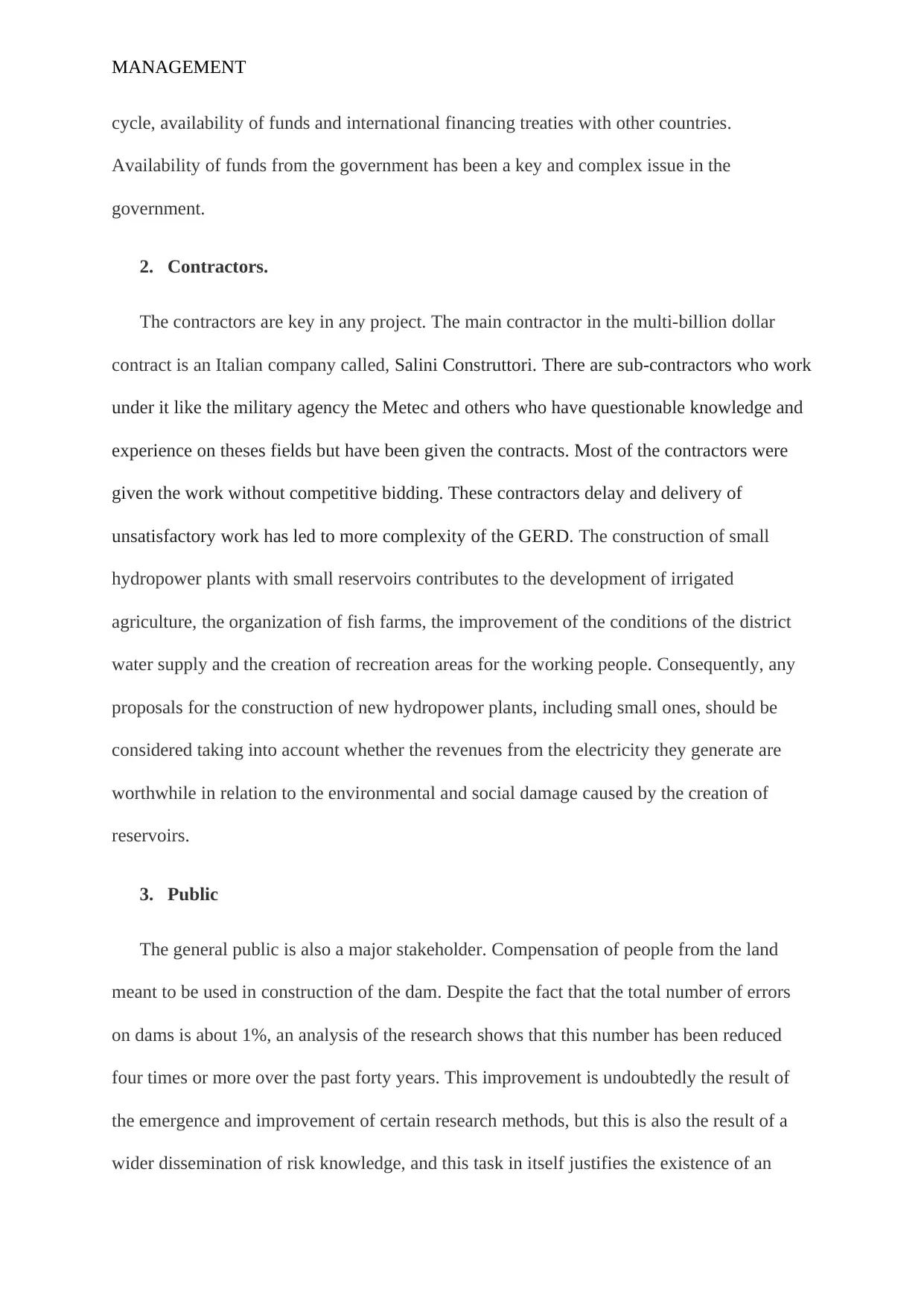
MANAGEMENT
cycle, availability of funds and international financing treaties with other countries.
Availability of funds from the government has been a key and complex issue in the
government.
2. Contractors.
The contractors are key in any project. The main contractor in the multi-billion dollar
contract is an Italian company called, Salini Construttori. There are sub-contractors who work
under it like the military agency the Metec and others who have questionable knowledge and
experience on theses fields but have been given the contracts. Most of the contractors were
given the work without competitive bidding. These contractors delay and delivery of
unsatisfactory work has led to more complexity of the GERD. The construction of small
hydropower plants with small reservoirs contributes to the development of irrigated
agriculture, the organization of fish farms, the improvement of the conditions of the district
water supply and the creation of recreation areas for the working people. Consequently, any
proposals for the construction of new hydropower plants, including small ones, should be
considered taking into account whether the revenues from the electricity they generate are
worthwhile in relation to the environmental and social damage caused by the creation of
reservoirs.
3. Public
The general public is also a major stakeholder. Compensation of people from the land
meant to be used in construction of the dam. Despite the fact that the total number of errors
on dams is about 1%, an analysis of the research shows that this number has been reduced
four times or more over the past forty years. This improvement is undoubtedly the result of
the emergence and improvement of certain research methods, but this is also the result of a
wider dissemination of risk knowledge, and this task in itself justifies the existence of an
cycle, availability of funds and international financing treaties with other countries.
Availability of funds from the government has been a key and complex issue in the
government.
2. Contractors.
The contractors are key in any project. The main contractor in the multi-billion dollar
contract is an Italian company called, Salini Construttori. There are sub-contractors who work
under it like the military agency the Metec and others who have questionable knowledge and
experience on theses fields but have been given the contracts. Most of the contractors were
given the work without competitive bidding. These contractors delay and delivery of
unsatisfactory work has led to more complexity of the GERD. The construction of small
hydropower plants with small reservoirs contributes to the development of irrigated
agriculture, the organization of fish farms, the improvement of the conditions of the district
water supply and the creation of recreation areas for the working people. Consequently, any
proposals for the construction of new hydropower plants, including small ones, should be
considered taking into account whether the revenues from the electricity they generate are
worthwhile in relation to the environmental and social damage caused by the creation of
reservoirs.
3. Public
The general public is also a major stakeholder. Compensation of people from the land
meant to be used in construction of the dam. Despite the fact that the total number of errors
on dams is about 1%, an analysis of the research shows that this number has been reduced
four times or more over the past forty years. This improvement is undoubtedly the result of
the emergence and improvement of certain research methods, but this is also the result of a
wider dissemination of risk knowledge, and this task in itself justifies the existence of an
Paraphrase This Document
Need a fresh take? Get an instant paraphrase of this document with our AI Paraphraser
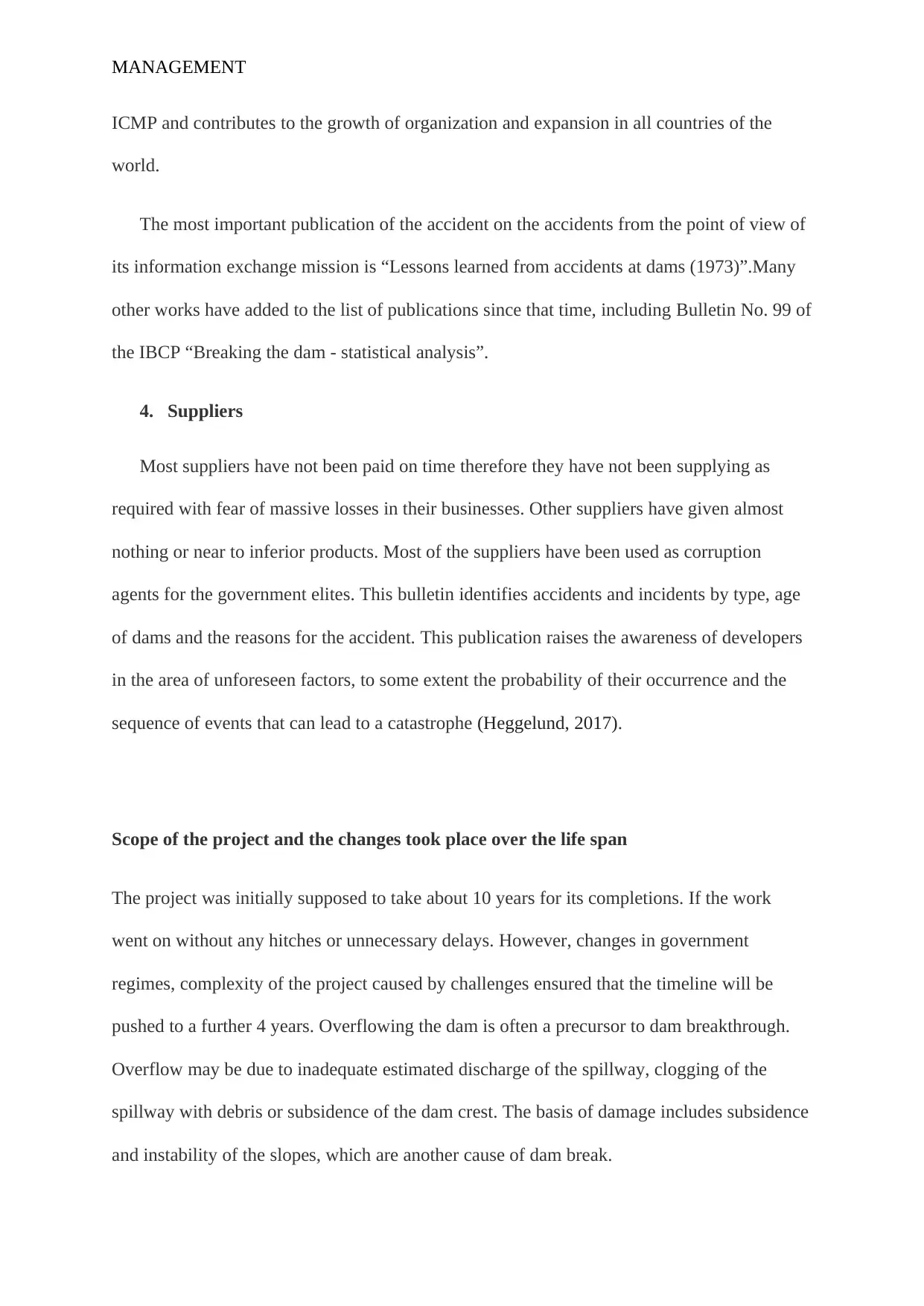
MANAGEMENT
ICMP and contributes to the growth of organization and expansion in all countries of the
world.
The most important publication of the accident on the accidents from the point of view of
its information exchange mission is “Lessons learned from accidents at dams (1973)”.Many
other works have added to the list of publications since that time, including Bulletin No. 99 of
the IBCP “Breaking the dam - statistical analysis”.
4. Suppliers
Most suppliers have not been paid on time therefore they have not been supplying as
required with fear of massive losses in their businesses. Other suppliers have given almost
nothing or near to inferior products. Most of the suppliers have been used as corruption
agents for the government elites. This bulletin identifies accidents and incidents by type, age
of dams and the reasons for the accident. This publication raises the awareness of developers
in the area of unforeseen factors, to some extent the probability of their occurrence and the
sequence of events that can lead to a catastrophe (Heggelund, 2017).
Scope of the project and the changes took place over the life span
The project was initially supposed to take about 10 years for its completions. If the work
went on without any hitches or unnecessary delays. However, changes in government
regimes, complexity of the project caused by challenges ensured that the timeline will be
pushed to a further 4 years. Overflowing the dam is often a precursor to dam breakthrough.
Overflow may be due to inadequate estimated discharge of the spillway, clogging of the
spillway with debris or subsidence of the dam crest. The basis of damage includes subsidence
and instability of the slopes, which are another cause of dam break.
ICMP and contributes to the growth of organization and expansion in all countries of the
world.
The most important publication of the accident on the accidents from the point of view of
its information exchange mission is “Lessons learned from accidents at dams (1973)”.Many
other works have added to the list of publications since that time, including Bulletin No. 99 of
the IBCP “Breaking the dam - statistical analysis”.
4. Suppliers
Most suppliers have not been paid on time therefore they have not been supplying as
required with fear of massive losses in their businesses. Other suppliers have given almost
nothing or near to inferior products. Most of the suppliers have been used as corruption
agents for the government elites. This bulletin identifies accidents and incidents by type, age
of dams and the reasons for the accident. This publication raises the awareness of developers
in the area of unforeseen factors, to some extent the probability of their occurrence and the
sequence of events that can lead to a catastrophe (Heggelund, 2017).
Scope of the project and the changes took place over the life span
The project was initially supposed to take about 10 years for its completions. If the work
went on without any hitches or unnecessary delays. However, changes in government
regimes, complexity of the project caused by challenges ensured that the timeline will be
pushed to a further 4 years. Overflowing the dam is often a precursor to dam breakthrough.
Overflow may be due to inadequate estimated discharge of the spillway, clogging of the
spillway with debris or subsidence of the dam crest. The basis of damage includes subsidence
and instability of the slopes, which are another cause of dam break.
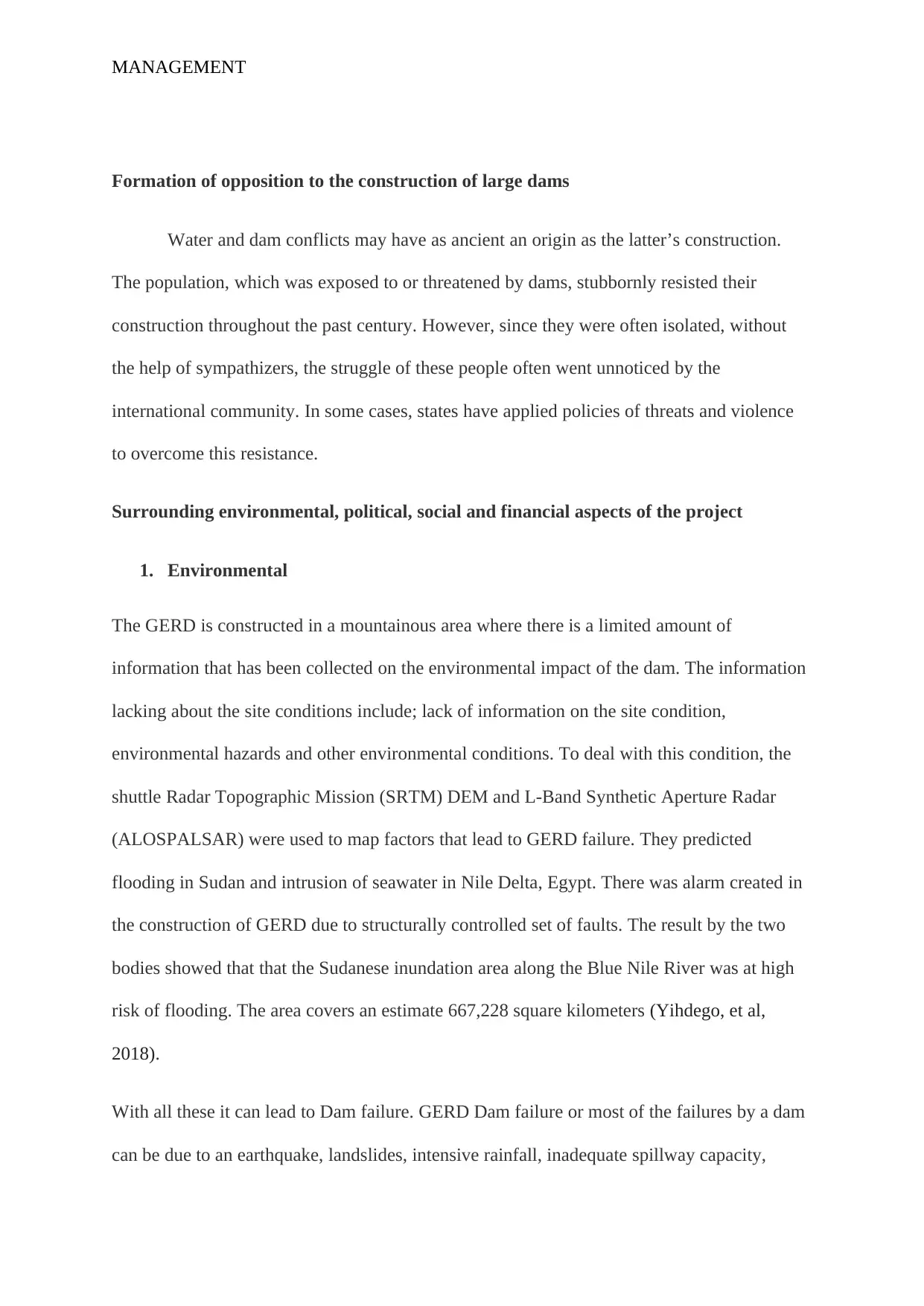
MANAGEMENT
Formation of opposition to the construction of large dams
Water and dam conflicts may have as ancient an origin as the latter’s construction.
The population, which was exposed to or threatened by dams, stubbornly resisted their
construction throughout the past century. However, since they were often isolated, without
the help of sympathizers, the struggle of these people often went unnoticed by the
international community. In some cases, states have applied policies of threats and violence
to overcome this resistance.
Surrounding environmental, political, social and financial aspects of the project
1. Environmental
The GERD is constructed in a mountainous area where there is a limited amount of
information that has been collected on the environmental impact of the dam. The information
lacking about the site conditions include; lack of information on the site condition,
environmental hazards and other environmental conditions. To deal with this condition, the
shuttle Radar Topographic Mission (SRTM) DEM and L-Band Synthetic Aperture Radar
(ALOSPALSAR) were used to map factors that lead to GERD failure. They predicted
flooding in Sudan and intrusion of seawater in Nile Delta, Egypt. There was alarm created in
the construction of GERD due to structurally controlled set of faults. The result by the two
bodies showed that that the Sudanese inundation area along the Blue Nile River was at high
risk of flooding. The area covers an estimate 667,228 square kilometers (Yihdego, et al,
2018).
With all these it can lead to Dam failure. GERD Dam failure or most of the failures by a dam
can be due to an earthquake, landslides, intensive rainfall, inadequate spillway capacity,
Formation of opposition to the construction of large dams
Water and dam conflicts may have as ancient an origin as the latter’s construction.
The population, which was exposed to or threatened by dams, stubbornly resisted their
construction throughout the past century. However, since they were often isolated, without
the help of sympathizers, the struggle of these people often went unnoticed by the
international community. In some cases, states have applied policies of threats and violence
to overcome this resistance.
Surrounding environmental, political, social and financial aspects of the project
1. Environmental
The GERD is constructed in a mountainous area where there is a limited amount of
information that has been collected on the environmental impact of the dam. The information
lacking about the site conditions include; lack of information on the site condition,
environmental hazards and other environmental conditions. To deal with this condition, the
shuttle Radar Topographic Mission (SRTM) DEM and L-Band Synthetic Aperture Radar
(ALOSPALSAR) were used to map factors that lead to GERD failure. They predicted
flooding in Sudan and intrusion of seawater in Nile Delta, Egypt. There was alarm created in
the construction of GERD due to structurally controlled set of faults. The result by the two
bodies showed that that the Sudanese inundation area along the Blue Nile River was at high
risk of flooding. The area covers an estimate 667,228 square kilometers (Yihdego, et al,
2018).
With all these it can lead to Dam failure. GERD Dam failure or most of the failures by a dam
can be due to an earthquake, landslides, intensive rainfall, inadequate spillway capacity,
⊘ This is a preview!⊘
Do you want full access?
Subscribe today to unlock all pages.

Trusted by 1+ million students worldwide
1 out of 27
Related Documents
Your All-in-One AI-Powered Toolkit for Academic Success.
+13062052269
info@desklib.com
Available 24*7 on WhatsApp / Email
![[object Object]](/_next/static/media/star-bottom.7253800d.svg)
Unlock your academic potential
Copyright © 2020–2025 A2Z Services. All Rights Reserved. Developed and managed by ZUCOL.




